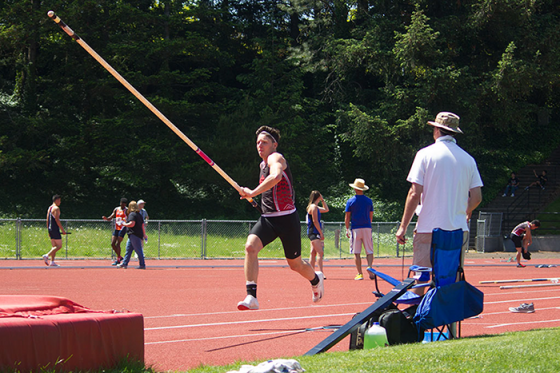The perfect vault
What once was used as a means to leap over enemy walls during ancient conflicts now stands as one of the most fascinating events in track and field: the pole vault.
Although the true birth of the sport is unknown, pole vaulting made its official modern-era Olympic debut in the 1896 Games in Athens, Greece.
Today, pole vaulting involves an athlete sprinting on a runway holding a flexible pole that he/she eventually slides (or “plants”) into a grooved slot (or “box”) that catches the pole, which flexes and propels the person upward – feet first – and over a hanging, horizontal crossbar.
The goal: Get as high as possible without knocking over the bar.
Pole vaulting is not for everyone, but for some athletes, it’s in their blood.
“It’s a huge feeling of satisfaction,” said Mt. Hood sophomore pole-vaulter Joshua Visan of clearing the bar. “All the work you put in is proven literally six inches from your face every time you clear the bar. The free-fall is just the cherry on top.”
There are four major phases in a successful vault, each step as crucial as the one before.
In the first phase, the vaulter sprints down the runway as fast as possible to transfer the most energy to the pole the vaulter will be planting in the box. Seeing as athletes reach their top speed anywhere between 10 to 12 strides, a start distance of just that is perfect.
Modern poles are made of fiberglass and carbon fiber. What once was made of hardwood has evolved into a light, flexible, and energy transferring, efficient pole; each pole designed for the vaulter’s height and weight.
In the second phase, the vaulter plants the pole in the box, ideally at about an 18-degree angle. This impact bends the pole to approximately 70 percent of its original height.
Next, the potential energy from the bent pole transfers to the athlete’s body and is used as kinetic energy: It’s a whipsaw effect. The vaulter uses this energy to pull his/her body into a handstand, of sorts, as the pole snaps back to straighten.
In the fourth and final phase, the vaulter in mid-air contorts his/her body to face the crossbar that he/she is attempting to clear. The vaulter then free-falls onto a large foam pad that’s waiting below as they clear the bar.
Visan, who holds a personal best vault of 4.17 meters (13 feet, 6 inches), discussed the importance of routine when vaulting.
“Routine (that) could be translated as consistency and consistency, is key in pole vault because every inch matters and if you’re even the slightest bit off mentally or physically, then you’re not going to be able to jump properly,” Visan said.
The world record for the pole vault stands at an astonishing 6.16 meters.The mark was set indoors last year by Renaud Lavillenie of France.
The sport that requires such great speed, strength, and focus also comes with its dangers.
According to a recent NCAA study, a total of 48 pole vaulters died between 1983 and 2010 from injuries sustained while vaulting. Another study found that 81 percent of vaulters get injured at some point during their vaulting careers. The primary issue is, athletes falling from such great heights.
Pole vaulters such as Visan find it a captivating sport that challenges both the mind and the body, however. Through years of practice and training, vaulters are able to accomplish something most can’t: a perfect vault.
Visan, who is heading to Spokane to vault in the NWAC Track and Field Championships on Monday-Tuesday, spoke on what pole vaulting means to him.
“It’s a way to be unique. It’s my thing,” he said. “I do it because I like it.”



Leave a comment